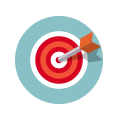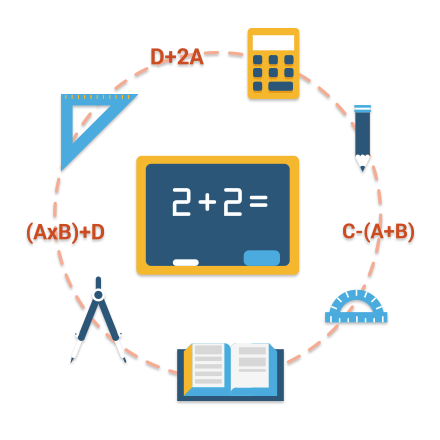Year 8 Maths
One of the main differences between Key Stage 2 and Key Stage 3 mathematics is that as you progress through Key Stage 3 you learn new skills and topics more frequently. In year 8 you will be taught an introduction to percentages including relating common fractions to percentages, changing fractions and decimals to percentages using tenths and hundredths as well as changing percentages to fractions and decimals. In addition to this you will learn the rules for indices and expressions; adding indices when multiplying terms with the same base, subtracting indices when dividing terms with the same base and multiplying indices when raising a power to a power. Although in previous years, Year 7 Maths you will have been introduced to statistics and the mean, you will now learn how to find the range, mode and median of grouped data and from a frequency distribution too and you will take this even further in Year 9 Maths.
.Popular Maths Curriculum Courses in England.
Key Stage 3
Year 9 Maths
Year 9 explains topics such as trigonometric ratios, constructions and loci, circumcentre and incentre and Pythagorean triples.
Key Stage 4
Foundation Maths
Experimental probability, relative frequency, equations involving grouping symbols are some of the areas taught in Foundation Maths.
Key Stage 4
Higher Mathematics
At Higher Mathematics you will be taught surds, surface are formulae and you will also be introduced to circle geometry as well.
Key Stage 5
Core Mathematics
You will learn algebra-polynomials, polynomial equations, the remainder theorem, absolute value and roots quad equations.



KS 3 Maths Topics
#
TOPIC
TITLE
1
Counting and numeration
Addition to 9999 and beyond
Objective: On completion of the lesson the student will be able to use the student’s knowledge of place value to solve addition problems with 3, 4 and 5 digit numbers and word problems.
2
Subtraction
Subtraction involving four digit numbers and beyond using the renaming method.
Objective: On completion of the lesson the student will be able to use written methods to solve subtraction problems involving 4 and 5 digit whole numbers.
3
Multiplication
Multiplying 2-digit numbers by 2-digit numbers
Objective: On completion of the lesson the student will be able to multiply any 2 digit number by any other 2 digit number.
4
Multiplication
Multiplying 4-digit numbers by 3-digit numbers
Objective: On completion of the lesson the student will be able to multiply any 4 digit numbers by any 3 digit numbers using long multiplication.
5
Multiplication
Multiplying 4-digit numbers by 4-digit number
Objective: On completion of the lesson the student will be able to be able to multiply any 4 digit number by any other 4 digit number using long multiplication.
6
Division/repeat subtraction
Repeated subtraction with divisors greater than 20 with remainders as fractions
Objective: On completion of the lesson the student will be able to use long division by repeated subtraction with divisors greater than 20 and remainders expressed as fractions
7
Division/repeat subtraction
Repeated subtraction with divisors less than 35 with some remainders
Objective: On completion of the lesson the student will be able to use long division by repeated subtraction with divisors less than 35, with some remainders.
8
Division/repeat subtraction
Repeated subtraction with divisors less than 55 with dividends of 3 and 4-digits with some remainders
Objective: On completion of the lesson the student will be able to use long division by repeated subtraction with divisors less than 55 and where dividends are 3 and 4 digit numbers, and there are some remainders.
9
Division/repeat subtraction
Repeated subtraction with divisors greater than 50 with dividends of thousands and some remainders
Objective: On completion of the lesson the student will able to use Long Division by repeated subtraction with divisors greater than 50 including division of thousands, and some remainders.
10
Multiplication
Multiples and factors of whole numbers
Objective: On completion of the lesson the student will be able to specify multiples and factors of whole numbers, and calculate the product of squared numbers.
| # | TOPIC | TITLE | |
|---|---|---|---|
| 1 | Counting and numeration | Addition to 9999 and beyond | |
| Objective: On completion of the lesson the student will be able to use the student’s knowledge of place value to solve addition problems with 3, 4 and 5 digit numbers and word problems. | |||
| 2 | Subtraction | Subtraction involving four digit numbers and beyond using the renaming method. | |
| Objective: On completion of the lesson the student will be able to use written methods to solve subtraction problems involving 4 and 5 digit whole numbers. | |||
| 3 | Multiplication | Multiplying 2-digit numbers by 2-digit numbers | |
| Objective: On completion of the lesson the student will be able to multiply any 2 digit number by any other 2 digit number. | |||
| 4 | Multiplication | Multiplying 4-digit numbers by 3-digit numbers | |
| Objective: On completion of the lesson the student will be able to multiply any 4 digit numbers by any 3 digit numbers using long multiplication. | |||
| 5 | Multiplication | Multiplying 4-digit numbers by 4-digit number | |
| Objective: On completion of the lesson the student will be able to be able to multiply any 4 digit number by any other 4 digit number using long multiplication. | |||
| 6 | Division/repeat subtraction | Repeated subtraction with divisors greater than 20 with remainders as fractions | |
| Objective: On completion of the lesson the student will be able to use long division by repeated subtraction with divisors greater than 20 and remainders expressed as fractions | |||
| 7 | Division/repeat subtraction | Repeated subtraction with divisors less than 35 with some remainders | |
| Objective: On completion of the lesson the student will be able to use long division by repeated subtraction with divisors less than 35, with some remainders. | |||
| 8 | Division/repeat subtraction | Repeated subtraction with divisors less than 55 with dividends of 3 and 4-digits with some remainders | |
| Objective: On completion of the lesson the student will be able to use long division by repeated subtraction with divisors less than 55 and where dividends are 3 and 4 digit numbers, and there are some remainders. | |||
| 9 | Division/repeat subtraction | Repeated subtraction with divisors greater than 50 with dividends of thousands and some remainders | |
| Objective: On completion of the lesson the student will able to use Long Division by repeated subtraction with divisors greater than 50 including division of thousands, and some remainders. | |||
| 10 | Multiplication | Multiples and factors of whole numbers | |
| Objective: On completion of the lesson the student will be able to specify multiples and factors of whole numbers, and calculate the product of squared numbers. | |||
See More Topics Covered in Year 8 Key Stage 3 Maths
..









